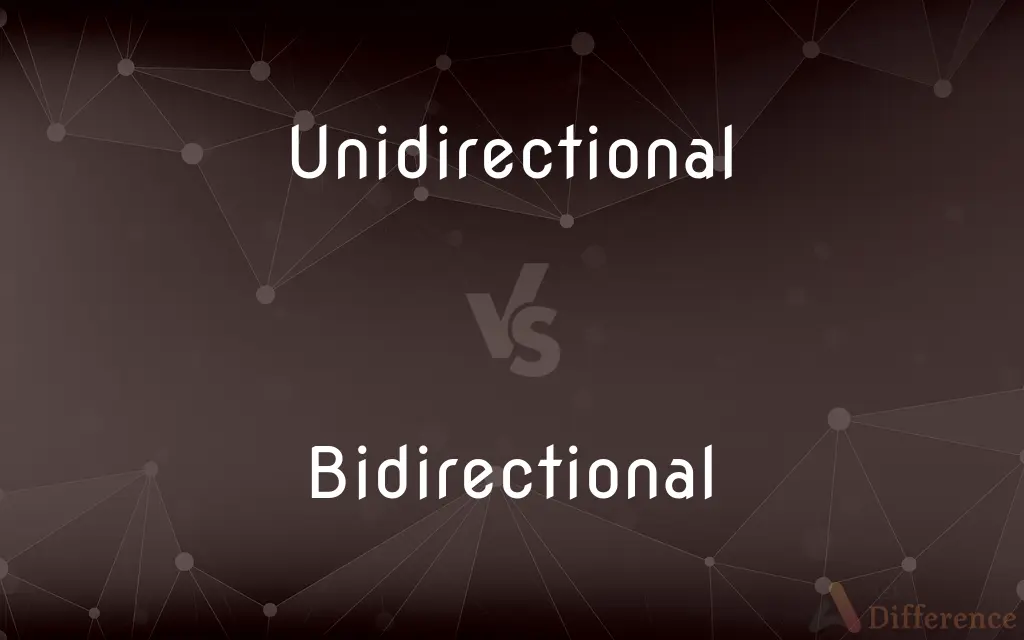Unidirectional vs. Bidirectional — What's the Difference?
By Maham Liaqat & Fiza Rafique — Updated on March 11, 2024
Unidirectional systems allow communication in one direction, while bidirectional systems support communication in both directions.

Difference Between Unidirectional and Bidirectional
Table of Contents
ADVERTISEMENT
Key Differences
Unidirectional communication or data flow means that information moves in a single, predefined direction, from a sender to a receiver without expecting a response directly on the same channel. Bidirectional communication, on the other hand, allows for two-way exchange of information, enabling both parties to act as sender and receiver.
This setup of unidirectional is commonly found in broadcast media, such as television and radio, where the content is transmitted from a central source to a wide audience, but the audience cannot respond through the same channel. This model of bidirectional is essential for interactive systems, such as telephones and the internet, where immediate response or exchange of data is necessary for the system's functionality.
In unidirectional systems, the design often emphasizes simplicity and efficiency in delivering content or data from one point to another without necessitating a return path. This can result in lower complexity and potentially lower costs in certain contexts, like one-way sensor data transmission to a central monitoring system. Bidirectional systems, whereas, are designed to facilitate interaction, collaboration, or any scenario requiring real-time or near-real-time exchanges. This complexity allows for more dynamic and responsive systems but often at the cost of increased design complexity and potentially higher resource requirements.
The choice between unidirectional and bidirectional communication systems depends on the application's specific needs. Unidirectional systems are well-suited for applications where information sharing is one-sided, such as broadcasting. Bidirectional systems are necessary for interactive applications, such as online gaming or instant messaging, where users expect to give and receive information fluidly.
Comparison Chart
Direction of Communication
One-way, sender to receiver
Two-way, allows both sending and receiving
ADVERTISEMENT
Complexity
Generally simpler, with no need for return path
More complex, must handle two-way data flow
Typical Applications
Broadcasting, alerts, notifications
Conversations, online transactions, real-time control
Interactivity
Minimal to none, not designed for response
High, designed for immediate or near-immediate response
Example
TV broadcasting, RSS feeds
Telephones, chat applications
Compare with Definitions
Unidirectional
Communication or data flow in one direction only, from sender to receiver.
A weather alert system broadcasts warnings to the public without receiving feedback.
Bidirectional
In networking, bidirectional traffic supports interactive and responsive communications.
In peer-to-peer networking, nodes can request and provide resources, enabling efficient data distribution.
Unidirectional
In networking, refers to traffic that flows from a source to a destination without reciprocation.
A monitoring tool collects data from various network devices without sending data back.
Bidirectional
In programming, a bidirectional data flow enables components to both send and receive data, increasing flexibility.
In websockets, the server and client can push messages to each other without polling.
Unidirectional
In transportation, unidirectional travel paths reduce conflicts and streamline traffic flow.
One-way streets in urban areas simplify navigation and reduce cross-traffic collisions.
Bidirectional
Refers to devices capable of handling signals or power in both directions, useful in versatile applications.
A reversible USB Type-C connector can be plugged in either way, supporting data and power bidirectionally.
Unidirectional
In programming, a unidirectional data flow restricts data to move in a single direction through components.
In React applications, data flows from parent to child components, enhancing predictability.
Bidirectional
Communication or data flow that allows exchange in both directions, enabling interactive exchanges.
A video call allows both participants to see and hear each other in real time.
Unidirectional
Applies to devices that send signals or power in one direction, enhancing efficiency in specific scenarios.
A diode allows electric current to flow in one direction, preventing reverse current flow.
Bidirectional
In transportation, bidirectional lanes accommodate traffic moving in both directions, requiring careful management.
A two-way street facilitates access to properties on both sides but may require traffic signals for safety.
Unidirectional
Moving or operating in one direction only
A unidirectional microphone.
Bidirectional
Moving or operating in two usually opposite directions
Bidirectional data flow.
Unidirectional
Pertaining to only one direction, e.g.: where all component parts are aligned in the same direction in space.
Bidirectional
Moving in two directions (usually opposite)
Unidirectional
A fabric in which the majority of fibers run in the same single direction.
Bidirectional
Operating or functioning in two directions (usually opposite)
Unidirectional
Operating or moving or allowing movement in one direction only;
A unidirectional flow
A unidirectional antenna
A unidirectional approach to a problem
Bidirectional
Such an antenna or microphone
Bidirectional
Reactive or functioning or allowing movement in two usually opposite directions
Common Curiosities
Why choose unidirectional over bidirectional communication?
Unidirectional communication is chosen for simplicity, efficiency, and specific scenarios where a response is not needed.
Can a system be both unidirectional and bidirectional?
A system can have components that are unidirectional and bidirectional, but its overall function is typically defined by its primary mode of communication.
What is unidirectional communication?
Unidirectional communication allows data flow in one direction only, from a sender to a receiver.
Why might a transportation system use unidirectional travel paths?
To streamline traffic flow, reduce conflicts, and increase safety by minimizing points of intersection.
What are examples of unidirectional devices?
Examples include broadcast antennas, diodes, and one-way valves.
How does bidirectional communication enhance online interactions?
It supports real-time, interactive exchanges, making digital communications more engaging and efficient.
Is the internet unidirectional or bidirectional?
The internet is primarily bidirectional, facilitating interactive data exchange.
What is bidirectional communication?
Bidirectional communication supports data exchange in both directions, enabling both parties to send and receive information.
How does unidirectional communication benefit broadcasting?
It allows efficient dissemination of information to a wide audience without requiring a return channel.
What role do unidirectional paths play in network monitoring?
They enable the collection of data from monitored devices without the need to send data back, simplifying infrastructure.
What are examples of bidirectional devices?
Examples include smartphones, two-way radios, and reversible USB connectors.
Do unidirectional systems require less maintenance than bidirectional systems?
Generally, yes, due to their simpler design and lack of need for managing return paths.
How do bidirectional systems handle data flow complexity?
They employ more sophisticated protocols and mechanisms to manage and optimize two-way communication.
Can unidirectional data flows enhance security?
Yes, by limiting the direction of data flow, they can reduce vulnerabilities to unauthorized access or data leakage.
What makes bidirectional lanes in transportation challenging?
Managing traffic flow in both directions requires careful planning and often, traffic control measures to ensure safety.
Share Your Discovery

Previous Comparison
Noose vs. Slipknot
Next Comparison
Push vs. PressAuthor Spotlight
Written by
Maham LiaqatCo-written by
Fiza RafiqueFiza Rafique is a skilled content writer at AskDifference.com, where she meticulously refines and enhances written pieces. Drawing from her vast editorial expertise, Fiza ensures clarity, accuracy, and precision in every article. Passionate about language, she continually seeks to elevate the quality of content for readers worldwide.
















































